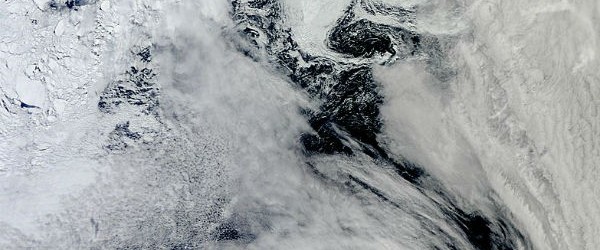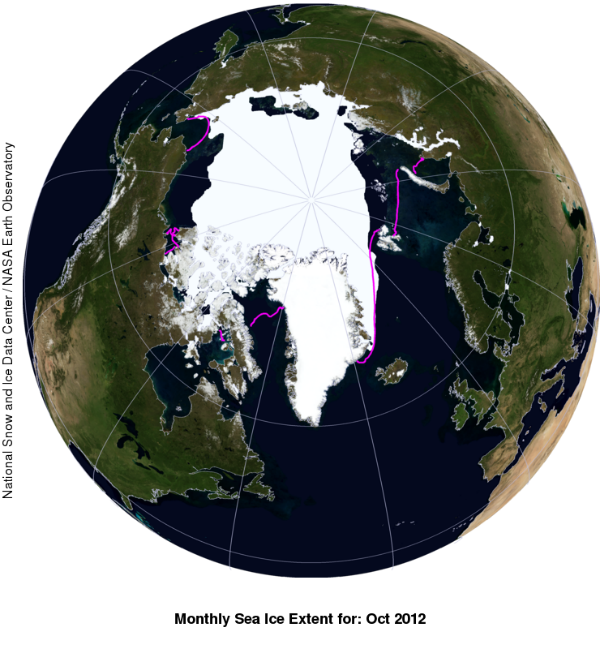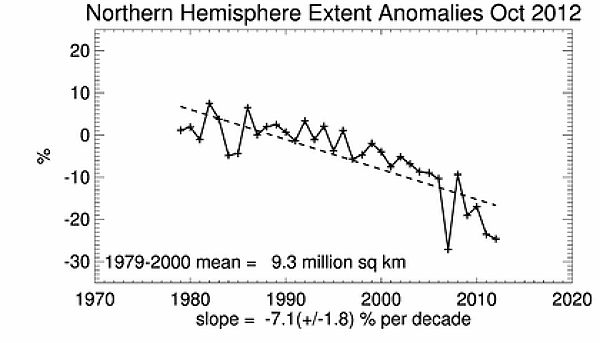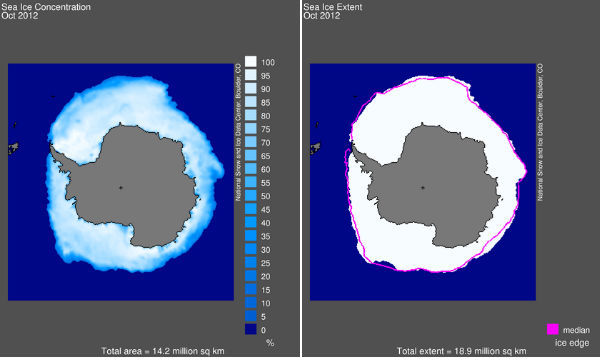Source: The Watchers - By Chillymanjaro, 11/18/12

Antarctic sea ice drift caused by changing winds are responsible for observed increases in Antarctic sea ice cover in the past two decades according to new study by British Antarctic Survey and NASA. While Arctic experienced dramatic record ice loss due the climate change, Antarctic sea ice cover has increased due the climate change. Antarctic ice cover expands to an area roughly twice the size of Europe during the winter season. By the end of winter the ice covers an area of 19 million square kilometres, more than doubling the size of the continent.
Monthly sea ice extent for October 2012 – Blue Marble view (Image courtesy of the National Snow and Ice Data Center, University of Colorado, Boulder and NASA Earth Observatory)
More than five million daily ice-motion measurements by four U.S. Defense Meteorological satellites, over a period of 19 years, were mapped by JPL and used in research. Scientists Paul Holland of the Natural Environment Research Council’s British Antarctic Survey and Ron Kwok of NASA’s Jet Propulsion Laboratory, analysed data which show long-term changes in sea ice drift around Antarctica for the first time. Before that, researchers used computer models of Antarctic winds.
Changes in the wind affect the ice cover through changes in ice drift and air temperature. Strong northward winds blow away sea ice around Antarctic. The total Antarctic sea ice cover is increasing slowly, but individual regions are actually experiencing much larger gains and losses that are almost offsetting each other overall according to new findings. The ice drift start to change from 1992.
Northern Hemisphere extent anomalies October 2012 (Image courtesy of the National Snow and Ice Data Center, University of Colorado, Boulder.)
This small Antarctic increase is actually the result of much larger regional increases and decreases, which are now shown to be caused by wind-driven changes. Arctic Ocean is surrounded by land so winds cannot cause Arctic ice to expand in the same way as in Antarctic. While East Antarctic has shown little change or even a small cooling around the coast, the Antarctic Peninsula has warmed as anywhere else in the Southern Hemisphere. Glacial ice of Antarctic Ice Sheet is losing its volume and frozen seawater is expanding. Glaciers drain ice from mountains to lower levels, where the ice either melts, breaks away into the sea as icebergs, or feeds into an ice shelf.
October 2012 sea ice total area and sea ice extent (Image courtesy of the National Snow and Ice Data Center, University of Colorado, Boulder.)
Sea Ice Index for October show that total total area of sea ice was 14.2 millions sq km with sea ice extent of 18.9 millions sq km.
The paper ‘Wind-driven trends in Antarctic sea ice motion’ by Paul R. Holland of British Antarctic Survey and Ron Kwok of the Jet Propulsion Laboratory, California, USA was published last week in the journal Nature Geosciences.
Further information about Arctic Ice and the record-breaking summer and winter
Antarctica Mosaic
Source: British Antarctic Survey, Sea Ice Index (NSIDC)
Featured image: Antarctica_r01c05 Subset – Terra 1km True Color 2012/323 (11/18) Rapid Response Imagery




